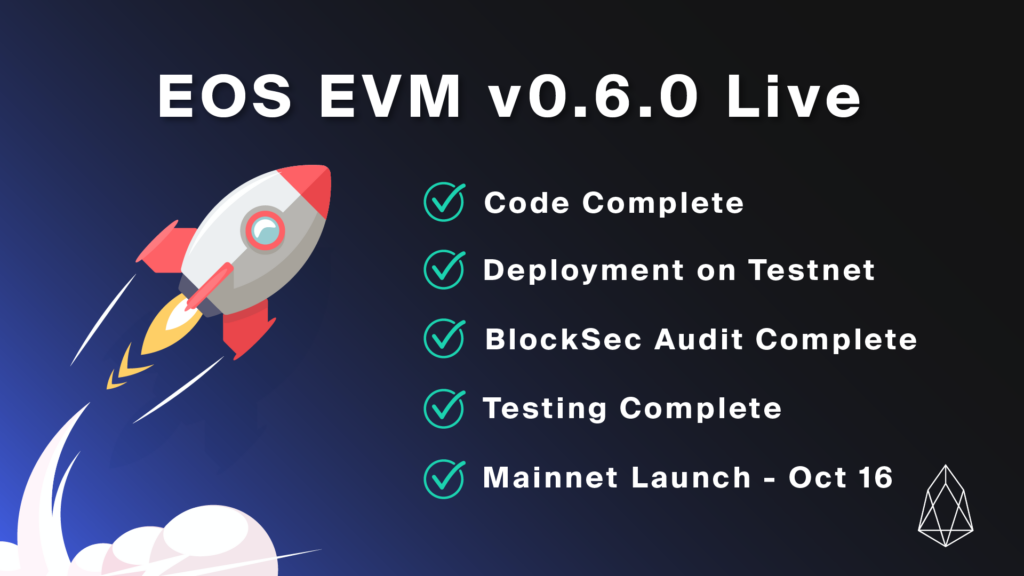
EOS EVM v0.6.0
New Features
- Trustless Bridge Support for ERC20 Tokens – New smart contracts deployed on both EOS EVM and EOS Native to support two way token bridging of altcoins.
- USDT (EOS Native) Added to Trustless Bridge – Users can deposit and withdraw USDT (EOS) to and from their EOS Native Accounts and Centralized Exchange Accounts to their EOS EVM Address.
- Cross Virtual Machine (VM) Communication – Smart contracts on EOS EVM and EOS Native can now call smart contracts on the opposite virtual machine, enabling new use cases that extend the functionality of EOS EVM that leverage the strengths of both Ethereum and EOS virtual machines.
Click here to learn more about all of the new features for EOS EVM.
Release Notes
- EOS EVM Smart Contract v0.6.0
- EOS EVM Node v0.6.0
- Trustless Bridge Frontend v0.9.0
- EOS EVM Trustless Bridge v0.1.0
Learn More About the EOS EVM v0.6.0 Release
Official USDT Support
This release marks a key milestone in the EOS ecosystem’s journey, as seamless interaction between EOS Native and EOS EVM is enabled.
EOS EVM v0.6.0 enhances the trustless bridge’s functionalities while keeping the platform fully EVM-compatible. Previously, only EOS could traverse the trustless bridge, however the upgrade to EOS EVM 0.6.0 will widen the horizon to the EOS Native version of USDT, which will be represented by an ERC-20 Token on the EOS EVM.
This new feature allows for users on EOS EVM access to USDT (EOS) without relying on any trust assumptions or 3rd party bridges.
Token Contract Addresses
Token Contract Address on EOS EVM: 0x33b57dc70014fd7aa6e1ed3080eed2b619632b8e
Token Contract Address on EOS Native: tethertether
How To
Transfer USDT to EOS EVM from an EOS Native Account
Depositing USDT to the EOS EVM can be done by initiating a token transfer for USDT (tethertether) to the ‘eosio.evmin’ EOS account with the receiving EVM public key in the memo field.
Transfer USDT (EOS) to EOS EVM from Centralized Exchanges
USDT can now be deposited and withdrawn to and from any centralized exchange that supports Tether for EOS Native. These exchanges include Binance, Bitfinex, Kucoin, MEXC, and GateIO.

Transfer USDT (EOS) from EOS EVM to EOS Native
USDT (EOS) can now be withdrawn from EOS EVM to EOS Native using the trustless bridge frontend.

EOS EVM References
Want to learn more about the EOS EVM and how you can take advantage of its unmatched performance? Check out the resources below:
- EOS EVM Product Backlog
- EOS EVM Web Portal
- EOS Ecosystem Explorer
- EOS EVM Developer Telegram
- EOS Developer Twitter
- EOS EVM GitHub
- Developer Docs
EOS Network
The EOS Network is a 3rd generation blockchain platform powered by the EOS VM, a low-latency, highly performant, and extensible WebAssembly engine for deterministic execution of near feeless transactions; purpose-built for enabling optimal Web3 user and developer experiences. EOS is the flagship blockchain and financial center of the Antelope framework, serving as the driving force behind multi-chain collaboration and public goods funding for tools and infrastructure through the EOS Network Foundation (ENF).
EOS EVM
The EOS EVM is an emulation of the Ethereum EVM, housed within an EOS smart contract. It offers feature parity to other EVMs in the space but with unmatched speed, performance and compatibility. EOS EVM connects the EOS ecosystem to the Ethereum ecosystem by allowing developers to deploy a wide array of Solidity-based digital assets and innovative dApps on EOS. Developers can use EOS EVM to take advantage of Ethereum’s battle-tested open source code, tooling, libraries and SDKs, while leveraging the superior performance of EOS.
EOS Network Foundation
The EOS Network Foundation (ENF) was forged through a vision for a prosperous and decentralized future. Through our key stakeholder engagement, community programs, ecosystem funding, and support of an open technology ecosystem, the ENF is transforming Web3. Founded in 2021, the ENF is the hub for EOS Network, a leading open source platform with a suite of stable frameworks, tools, and libraries for blockchain deployments. Together, we are bringing innovations that our community builds and are committed to a stronger future for all.



